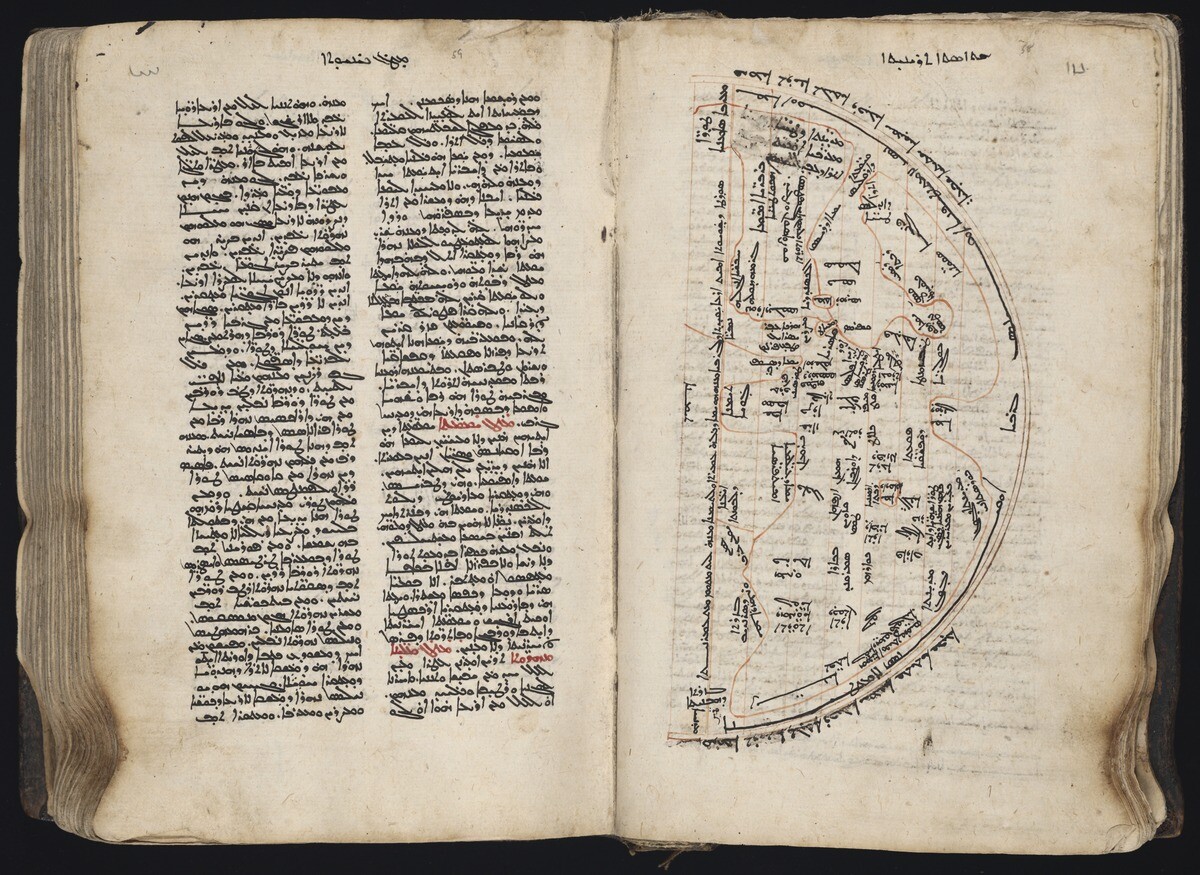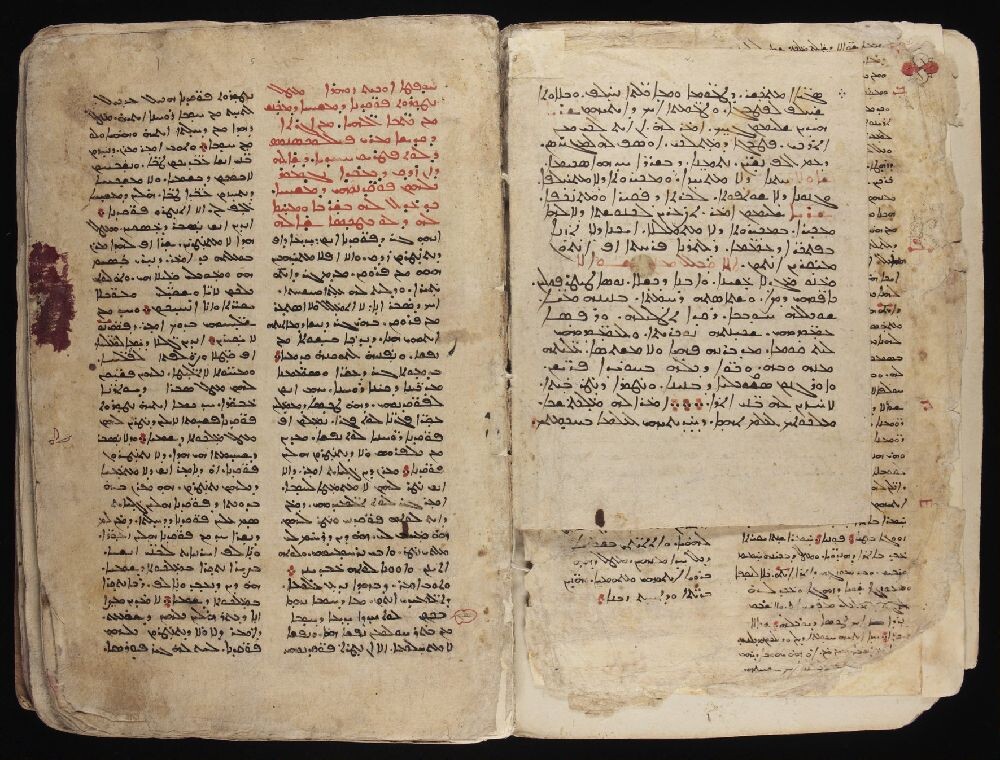Syriac, a semitic language related to Aramaic, has had an extremely long and fascinating life. It has seen use across centuries by people of diverse religious and cultural backgrounds, from pre-christian inscriptions found in ancient Edessa (now Şanlıurfa, Turkey) to scientific works of the later Middle Ages. The Syriac manuscripts in the collection of the Beinecke Rare Book & Manuscript Library contain a variety of texts: theological works, a lexicon, legal works, and histories of saints.
Use of Syriac extended well beyond the region now covered by the country of Syria. A language of religious, merchant, and scientific value, there is a fairly large, significant preserved corpus of Syriac texts. These manuscripts may be highly decorated or comparatively free of illumination, but they are complex manuscripts which attest to the many scholars, religious figures, government officials, and everyday people who made use of the Syriac language.

Syriac MS 10. 13th Century.
This 13th century apocalypse (or apokalypsis) is a testament to the long lives of manuscripts— from the much more modern fabric cover to the stained and well-annotated margins, the 483 pages of Syriac MS 10 has seen many users. Syriac MS 10 contains commentaries on the bible and the works of Moses bar Kepha (ca. 813 - 903), as well as apparent fragments of Philoxenus of Mabbug’s (d. 523) text on the Tree of Life. On page 31 recto, you can see two circular diagrams accompanied by extensive commentary along the right margin. The bottom diagram shows evidence that the figure was remade or corrected on a new piece of paper and then pasted upon the page, creating a sort of diagrammatic collage— just part of the extensive working and reworking that many books recieved over the course of their circulation.

Syriac MS 7. Unknown Date.
Syriac MS 7 contains Gregory Bar Hebraeus (1226-1286) ’s Kethabha dhe-Menarath Qudhshe (The Lamp of the Sanctuary), as well as three short additional texts, including a work by Jacob of Serug (451-521), added to the end of the manuscript. Bar Hebraeus was a Syrian Orthodox Bishop who wrote extensively on matters related to religon and theology, in addition to penning chronicles. On page 59 recto, shown on the right in the above opening, there is a diagrammatic map of the world, rendered in a half-moon shape, with divisions in red pen. While the paper pages of much of this manuscript are still bright and relatively unblemished, the fore-edge of the book shows evidence of damage, perhaps singed by the flame of a unmonitored candle– just one of the many dangers that pose a particular risk to a paper manuscript.

Syriac MS 11. 1699?
Like the other two examples above, Syriac MS 11 is written on paper in black and red ink. The above opening (1v-2r) reveals a well-organized and precisely ruled document with the edges bounded in thin lines of red ink. On page 2 recto, a beautiful geometric headpiece is filled with interlace in purple, white, yellow, red, and a deep navy. Line fillers using the same design appear throughout the manuscript. Like Syriac MS 7 above, the text is attributed to Bar Hebraeus, although it contains another of his works, Kethabha dhe-Hudhaye, a legal text.
Further Digitized Syriac Manuscripts at the Beinecke
AOS Rn32. Bible. Revelation of St. Paul.
AOS Rv B65. Ibn al-‘Assal, al-Safi Abu al-Fad a’il Majid. Yale Login Required.
AOS Rn C68. Syriac Theological Miscelleny. Yale Login Required.
Syriac MS 5. Histories of Histories of SS. Matthew and Andrew the Apostles, St. Abba Marcus of Mount Tharmaka, St. Cyriacus, and Julitta.
Syriac MS 8. Syriac Theological Miscellany.
Syriac MS 9. Syriac - Armenian Lexicon.
Syriac MS 13. Yohannan Bar Zo’bi. Memra on the matter of faith and interpretation of the Eucharist.
External Links and Further Resources
Syri.ac, An Annotated Bibliography of Syriac Resources Online
Library of Congress, Digitized Syriac Manuscripts from St. Catherine’s Monastery, Mount Sinai
The Hill Museum & Manuscript Library
Sebastian P. Brock An Introduction to Syriac Studies. Third Edition. Piscataway, NJ : Gorgias Press LLC, 2017.
Sebastian P. Brock A Brief Outline of Syriac Literature. Kottayam: St. Ephrem Ecumenical Research Institute, 1997.
Daniel King, editor. The Syriac World. New York: Routledge, 2018.
Jack Tannous, The Making of the Medieval Middle East: Religion, Society, and Simple Believers. Princeton, NJ: Princeton University Press, 2018
